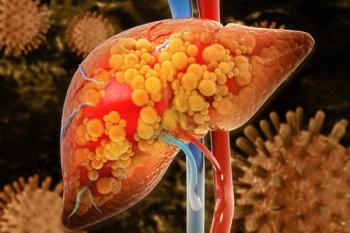
Ibrutinib-Based Frontline Regimens Narrow the Survival Gap in CLL
Key Takeaways
- Continuous and fixed-duration ibrutinib-based regimens deliver survival outcomes for CLL patients comparable to an age-matched European population.
- The study supports current CLL treatment recommendations, with continuous BTKi monotherapy for elderly patients and fixed-duration regimens for younger patients.
Modern ibrutinib-based approaches substantially narrow the traditional survival gap observed in CLL.
According to a new analysis published in
The analysis pooled patient-level data from 5 major trials in previously untreated CLL, including 3 evaluating continuous ibrutinib-based regimens (RESONATE-2, ECOG1912, and iLLUMINATE) and 2 evaluating fixed-duration ibrutinib-venetoclax (GLOW and the fixed-duration cohort of CAPTIVATE). A total of 865 patients were included, with 600 receiving continuous ibrutinib-based therapy and 265 receiving fixed-duration ibrutinib-venetoclax. Median follow-up was 49.7 months and 55.7 months, respectively. Survival outcomes were benchmarked against actuarial life-table estimates from the 2019 World Health Organization (WHO) European population, chosen to reflect pre-COVID-19 survival patterns.
In the continuous ibrutinib-based cohort, 45% of patients were aged 65 years or older, with a median age of 63 years. Unmutated IGHV genes were present in 55.2% of patients, and 9.3% had del(17p) or TP53 mutations. Treatment distribution varied by age, with single-agent ibrutinib being the predominant regimen among patients aged 65 years or older (50.2%), while ibrutinib-rituximab was most common among those younger than 65 years (93.4%). Patients in the fixed-duration ibrutinib-venetoclax cohort had a median age of 65 years, and the majority (58.9%) had unmutated IGHV, with 37% showing mutated IGHV and 8.7% carrying del(17p) or TP53 mutations.
The primary analysis showed that continuous ibrutinib-based regimens demonstrated OS estimates comparable to those of an age-matched general European population (HR, 1.23; 95% CI, 0.88-1.73; P = .228). Similarly, fixed-duration ibrutinib-venetoclax produced OS outcomes that were nearly identical to expected population survival (HR, 1.00; 95% CI, 0.57-1.76; P = .998).
Subgroup analyses reinforced these findings across multiple patient populations. In patients treated with continuous ibrutinib-based regimens, both single-agent ibrutinib and ibrutinib combined with anti-CD20 monoclonal antibodies showed OS similar to that of the age-matched population. The consistency persisted across both age groups and both unmutated and mutated IGHV status groups.
"This study demonstrates that both treatment approaches—continuous ibrutinib‐based regimens and fixed‐duration ibrutinib‐venetoclax—show comparable survival with an age‐matched general European population regardless of age and the presence of high‐risk genomic features, such as IGHV gene mutation status," the authors note. The results align with current treatment recommendations for CLL, which typically suggest continuous Bruton's tyrosine kinase inhibitor (BTKi) monotherapy for elderly patients with comorbidities, whereas younger patients without comorbidities are more commonly treated with fixed-duration regimens.2
The investigators acknowledged several limitations, including the use of simulated rather than observed control groups, pooled data from trials with varying inclusion and exclusion criteria, and relatively short follow-up periods. Additionally, the global nature of the trials may also limit direct comparability with European population data due to the lower life expectancy in some trial regions. The findings also cannot be extrapolated to all high-risk patient populations, particularly those with del(17p) or TP53 mutations, due to limited sample sizes in these subgroups.
These results add important context for comparative studies now underway, including the CLL17 trial evaluating fixed-duration venetoclax-obinutuzumab, fixed-duration ibrutinib-venetoclax, and continuous ibrutinib in previously untreated CLL.3 The authors noted that “Our analysis offers insight into key treatment approaches for CLL,” and the demonstration of population-level survival with both continuous and time-limited ibrutinib-based regimens supports flexible treatment selection as clinicians individualize therapy to age, comorbidities, and patient preference.
References
1. Ghia P, Ysebaert L, Janssens A, et al. Overall survival outcomes with first-line continuous ibrutinib and fixed-duration ibrutinib-venetoclax treatments in patients with chronic lymphocytic leukemia: Comparison with an age-matched European population. HemaSphere. 2025;9(10):e70246. doi:10.1002/hem3.70246
2. National Comprehensive Cancer Network. Chronic Lymphocytic Leukemia/Small Lymphocytic Lymphoma (Version 1.2026). Published October 1, 2025. Accessed November 19, 2025.
3. A study comparing fixed-duration venetoclax-obinutuzumab, fixed-duration ibrutinib-venetoclax, and ibrutinib in CLL (CLL17). Identifier NCT04608318. Updated December 31, 2024. Accessed November 18, 2025.
Newsletter
Stay ahead of policy, cost, and value—subscribe to AJMC for expert insights at the intersection of clinical care and health economics.












































